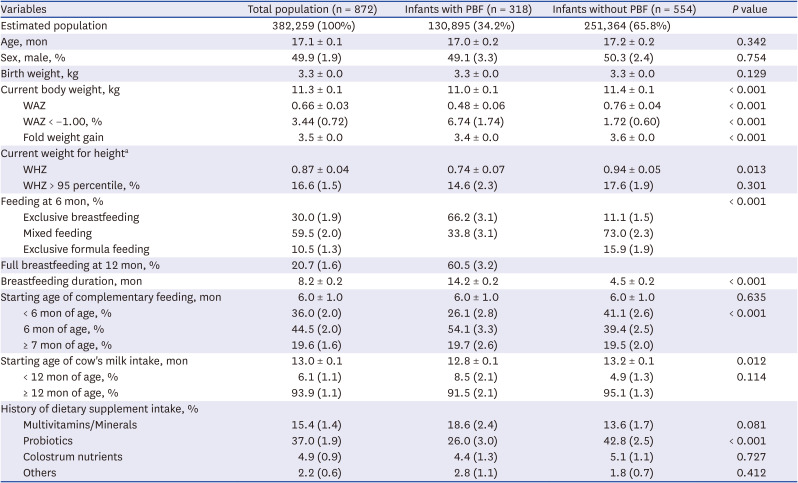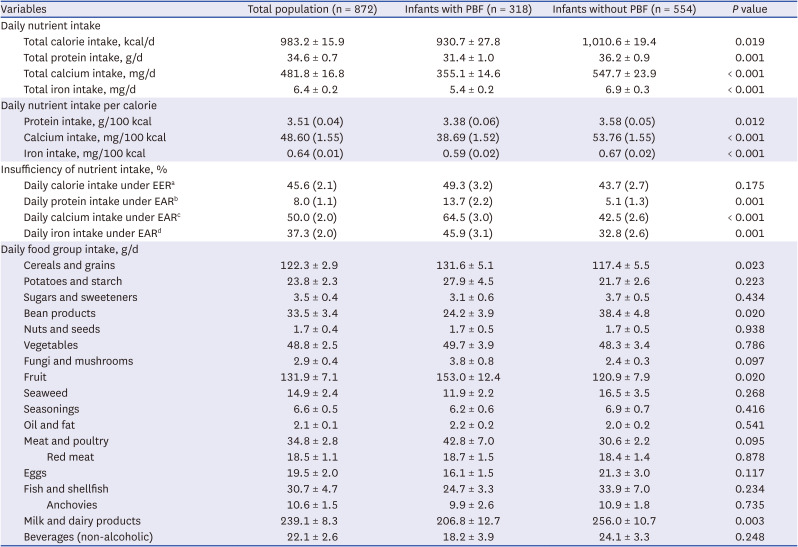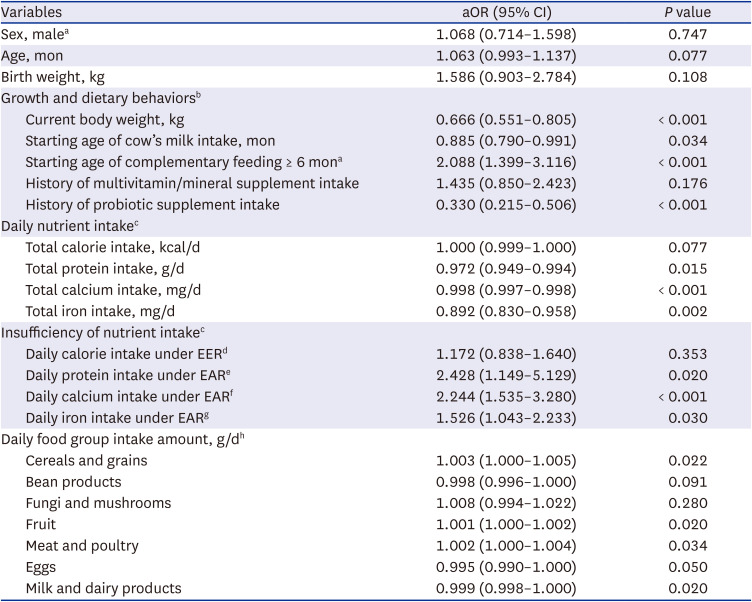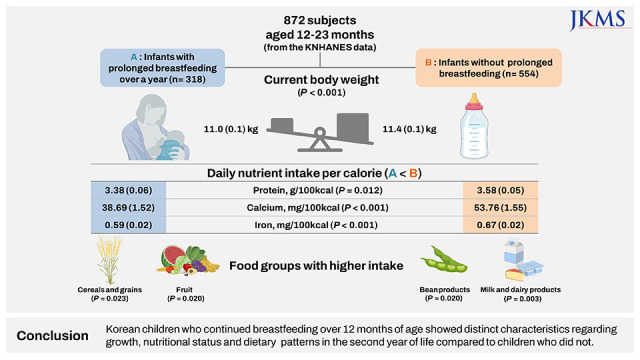1. Section on Breastfeeding. Breastfeeding and the use of human milk. Pediatrics. 2012; 129(3):e827–e841. PMID:
22371471.
2. World Health Organization. Global Strategy for Infant and Young Child Feeding. Geneva, Switzerland: World Health Organization;2003.
3. Kramer MS, Kakuma R. Optimal duration of exclusive breastfeeding. Cochrane Database Syst Rev. 2012; 2012(8):CD003517. PMID:
22895934.
4. Dewey KG, Cohen RJ, Rivera LL, Brown KH. Effects of age of introduction of complementary foods on iron status of breast-fed infants in Honduras. Am J Clin Nutr. 1998; 67(5):878–884. PMID:
9583845.
5. Jonsdottir OH, Thorsdottir I, Hibberd PL, Fewtrell MS, Wells JC, Palsson GI, et al. Timing of the introduction of complementary foods in infancy: a randomized controlled trial. Pediatrics. 2012; 130(6):1038–1045. PMID:
23147979.
6. Chantry CJ, Howard CR, Auinger P. Full breastfeeding duration and risk for iron deficiency in U.S. infants. Breastfeed Med. 2007; 2(2):63–73. PMID:
17661577.
7. Wang F, Liu H, Wan Y, Li J, Chen Y, Zheng J, et al. Prolonged exclusive breastfeeding duration is positively associated with risk of anemia in infants aged 12 months. J Nutr. 2016; 146(9):1707–1713. PMID:
27489010.
8. Maguire JL, Salehi L, Birken CS, Carsley S, Mamdani M, Thorpe KE, et al. Association between total duration of breastfeeding and iron deficiency. Pediatrics. 2013; 131(5):e1530–e1537. PMID:
23589818.
9. Hong J, Chang JY, Shin S, Oh S. Breastfeeding and red meat intake are associated with iron status in healthy Korean weaning-age infants. J Korean Med Sci. 2017; 32(6):974–984. PMID:
28480656.
10. Clark KM, Li M, Zhu B, Liang F, Shao J, Zhang Y, et al. Breastfeeding, mixed, or formula feeding at 9 months of age and the prevalence of iron deficiency and iron deficiency anemia in two cohorts of infants in China. J Pediatr. 2017; 181:56–61. PMID:
27836288.
11. Fewtrell M, Bronsky J, Campoy C, Domellöf M, Embleton N, Fidler Mis N, et al. Complementary feeding: a position paper by the European Society for Paediatric Gastroenterology, Hepatology, and Nutrition (ESPGHAN) committee on nutrition. J Pediatr Gastroenterol Nutr. 2017; 64(1):119–132. PMID:
28027215.
12. Miniello VL, Verga MC, Miniello A, Di Mauro C, Diaferio L, Francavilla R. Complementary feeding and iron status: “the unbearable lightness of being” infants. Nutrients. 2021; 13(12):4201. PMID:
34959753.
13. Baker RD, Greer FR. Committee on Nutrition American Academy of Pediatrics. Diagnosis and prevention of iron deficiency and iron-deficiency anemia in infants and young children (0-3 years of age). Pediatrics. 2010; 126(5):1040–1050. PMID:
20923825.
14. Moon JS. Nutritional management of breastfeeding infants for the prevention of common nutrient deficiencies and excesses. Korean J Pediatr. 2011; 54(7):282–286. PMID:
22025920.
15. Moshe G, Amitai Y, Korchia G, Korchia L, Tenenbaum A, Rosenblum J, et al. Anemia and iron deficiency in children: association with red meat and poultry consumption. J Pediatr Gastroenterol Nutr. 2013; 57(6):722–727. PMID:
24280989.
16. Cox KA, Parkin PC, Anderson LN, Chen Y, Birken CS, Maguire JL, et al. Association between meat and meat-alternative consumption and iron stores in early childhood. Acad Pediatr. 2016; 16(8):783–791. PMID:
26804490.
17. Kweon S, Kim Y, Jang MJ, Kim Y, Kim K, Choi S, et al. Data resource profile: the Korea National Health and Nutrition Examination Survey (KNHANES). Int J Epidemiol. 2014; 43(1):69–77. PMID:
24585853.
18. Kim JH, Yun S, Hwang SS, Shim JO, Chae HW, Lee YJ, et al. The 2017 Korean National Growth Charts for children and adolescents: development, improvement, and prospects. Korean J Pediatr. 2018; 61(5):135–149. PMID:
29853938.
19. Ministry of Health and Welfare (KR). The Korean Nutrition Society. Dietary Reference Intakes for Koreans 2020. Sejong, Korea: Ministry of Health and Welfare;2020.
20. Zong XN, Li H, Zhang YQ, Wu HH. Growth performance comparison of exclusively breastfed infants with partially breastfed and formula fed infants. PLoS One. 2020; 15(8):e0237067. PMID:
32817664.
21. de Beer M, Vrijkotte TG, Fall CH, van Eijsden M, Osmond C, Gemke RJ. Associations of infant feeding and timing of linear growth and relative weight gain during early life with childhood body composition. Int J Obes. 2015; 39(4):586–592.
22. Anderson CE, Whaley SE, Crespi CM, Wang MC, Chaparro MP. Every month matters: longitudinal associations between exclusive breastfeeding duration, child growth and obesity among WIC-participating children. J Epidemiol Community Health. 2020; 74(10):785–791. PMID:
32611693.
23. Dewey KG, Heinig MJ, Nommsen LA, Peerson JM, Lönnerdal B. Growth of breast-fed and formula-fed infants from 0 to 18 months: the DARLING Study. Pediatrics. 1992; 89(6 Pt 1):1035–1041. PMID:
1594343.
24. Kwak JY, Park JY, Lee HJ, Jung HJ, Son SH, Jung SJ. Growth patterns of breast fed and formula fed infants. Korean J Pediatr. 2005; 48(10):1055–1060.
25. Kang S, Lee SW, Cha HR, Kim SH, Han MY, Park MJ. Growth in exclusively breastfed and non-exclusively breastfed children: Comparisons with WHO child growth standards and Korean national growth charts. J Korean Med Sci. 2021; 36(47):e315. PMID:
34873884.
26. Moon JS. Application of 2007 Korean national growth charts: growth curves and tables. Korean J Pediatr Gastroenterol Nutr. 2009; 12(Suppl 1):S1–S5.
27. Park JS, Chang JY, Hong J, Ko JS, Seo JK, Shin S, et al. Nutritional zinc status in weaning infants: association with iron deficiency, age, and growth profile. Biol Trace Elem Res. 2012; 150(1-3):91–102. PMID:
23054863.
28. Kim YH, Lee SG, Kim SH, Song YJ, Chung JY, Park MJ. Nutritional status of Korean toddlers: from the Korean National Health and Nutrition Examination Survey 2007~2009. Korean J Pediatr Gastroenterol Nutr. 2011; 14(2):161–170.
30. Kwon SH. Food sources of nutrient intake in Korea National Health and Nutrition Examination Survey. Public Health Wkly Rep. 2019; 12(32):1132–1140.
31. Eldridge AL, Catellier DJ, Hampton JC, Dwyer JT, Bailey RL. Trends in mean nutrient intakes of US infants, toddlers, and young children from 3 feeding infants and toddlers studies (FITS). J Nutr. 2019; 149(7):1230–1237. PMID:
31049587.
32. Ballard O, Morrow AL. Human milk composition: nutrients and bioactive factors. Pediatr Clin North Am. 2013; 60(1):49–74. PMID:
23178060.
34. Kim EY. Improvement of the screening program for infants and children in the National Health Screening System. Public Health Wkly Rep. 2021; 14(2):58–67.
35. Barthow C, Wickens K, Stanley T, Mitchell EA, Maude R, Abels P, et al. The Probiotics in Pregnancy Study (PiP Study): rationale and design of a double-blind randomised controlled trial to improve maternal health during pregnancy and prevent infant eczema and allergy. BMC Pregnancy Childbirth. 2016; 16(1):133. PMID:
27255079.
36. Kim SK, Kim YK, Kim HR, Park JS, Son CK, Choi Y, et al. The 2012 National Survey on Fertility, Family Health & Welfare in Korea. Sejong, Korea: Korea Institute for Health and Social Affairs;2012.
37. Heinig MJ, Nommsen LA, Peerson JM, Lonnerdal B, Dewey KG. Energy and protein intakes of breast-fed and formula-fed infants during the first year of life and their association with growth velocity: the DARLING study. Am J Clin Nutr. 1993; 58(2):152–161. PMID:
8338041.
38. Weber M, Grote V, Closa-Monasterolo R, Escribano J, Langhendries JP, Dain E, et al. Lower protein content in infant formula reduces BMI and obesity risk at school age: follow-up of a randomized trial. Am J Clin Nutr. 2014; 99(5):1041–1051. PMID:
24622805.
39. Nam GE. Consideration in analysis of nutrition survey data from Korea National Health and Nutrition. Korean J Fam Pract. 2017; 7(1):1–2.







 PDF
PDF Citation
Citation Print
Print




 XML Download
XML Download